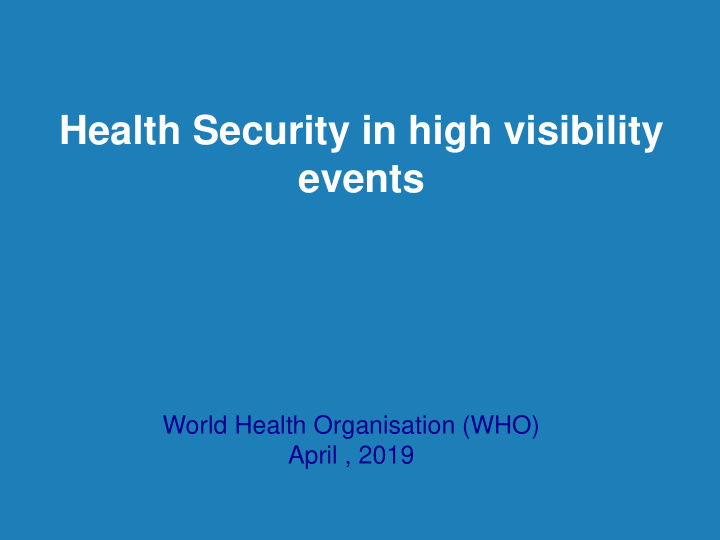



Health Security in high visibility events World Health Organisation (WHO) April , 2019
Context of emerging/epidemic disease in the 21st. century Emergence of new or newly recognised pathogens (e.g. Avian flu (H5N1), SARS, Ebola, Marburg, H1N1) Resurgence of well characterized outbreak-prone diseases (e.g. cholera, dengue, measles, meningitis, shigellosis, yellow fever) Release (accidental or deliberate) of a biological agent (e.g. BSE /vCJD, smallpox, SARS, anthrax). 2 | WHO Health Security Interface | May 8, 2019
The legal framework has changed to deal with new threats International Health Regulations IHR(2005), an international paradigm shift International traffic, trade and tourism From three diseases to all public health threats From preset measures to risk assessment response From control of borders to, also, containment at source 3 | WHO Health Security Interface | May 8, 2019
Mass gatherings challenges Health systems are stretched to surge capacity MG may require host countries to adopt additional measures to comply with IHR (2005) - under intense media scrutiny Business-as-usual behavioural health measures difficult/impossible to implement Require holistic approaches to risk mitigation across disciplines/ministries Introduction and dissemination of non- endemic diseases Communication of risk made difficult by international dimension (languages, cultures, etc) and media pressures 4 | WHO Health Security Interface | May 8, 2019
Health risks of mass gatherings Importation/exportation of communicable diseases Communicable disease outbreaks Food and water Crime and accidental Injuries Temperature-related illness Drug/alcohol-related illness Deliberate events – Chemical – Biological – Radiation – Nuclear – Explosive. 5 | WHO Health Security Interface | May 8, 2019
Contextual pressure High-profile Global Security perception sponsorships interconnectedness Media visibility Health security Communications and context technology 6 | WHO Health Security Interface | May 8, 2019
Need for interdisciplinary coordination 7 | WHO Health Security Interface | May 8, 2019
Working Definition – "Health Security Interface" The mandate of the HSI Secretariat is applicable to those public health activities within WHO whose performance involves to some extent the security sector. This includes (but is not limited to) work involving: international organizations, civil defence, military doctors, law enforcement and armed forces. 8 | WHO Health Security Interface | May 8, 2019
WHO HSI Increasing collaboration horizontally .1 through headquarters thus involving all necessary departments and teams whose knowledge will provide vital expertise for HSI activities; Accelerating and improving .2 coordination between headquarters, regional, and country efforts; Increasing collaboration with the .3 many external parties involved in response to health emergencies. 9 | WHO Health Security Interface | May 8, 2019
BASIC LESSONS 1. HOLISTIC PLANNING NO MINISTRY HAS ALL THE CAPACITY. YOU MUST ALL WORK TOGETHER 2. START PLANNING EARLY STARTING EARLY WILL ALLOW YOU TO WORK OUT ANY PROBLEMS AND TRAIN AND IMPROVE ANY PLAN 3. PLAN FOR LEGACY POSITIVE LEGACY WILL NOT JUST OCCUR – IT MUST BE PLANNED FOR 10 | WHO Health Security Interface | May 8, 2019
Recommend
More recommend